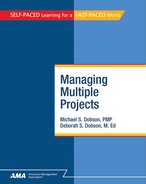About This Course
Managing Multiple Projects is a vital element in AMA’s self-study program on project management, because—let’s face it—who among us has only a single project? Multiple projects are the norm, not the exception, and there are very good reasons why this is so. A lot of projects simply aren’t big enough to justify the investment of a full-time project manager: having only one is impractical. Depending on the availability of resources, a multiple project environment can accomplish substantial work while lowering the overhead burden of project management by consolidating processes.
There are three broad levels of multiple project management, each with issues and strategies you need to know:
Task Managers. Most professionals and many administrative staff manage multiple small projects along with day-to-day responsibilities. Debbie is currently planning an upcoming executive retreat, overseeing a contractor developing internal training, and writing this book, all while managing the day-to-day functions of her job in leadership development. In this sense, managing multiple projects involves a blend of classical time management and basic project management.
Program Managers. Some managers are responsible for the development and execution of multiple projects for clients and customers. Michael once managed product development in the game and toy industry. Five designers, five editor/developers, and one outside acquisitions coordinator produced 65 new products a year. The management job focused on production scheduling and quality assurance, and involved a range of classical project management skills.
Project Executives. At some point a project becomes large enough that its major components are also projects. Your company decides to move its corporate headquarters from one city to another, and you’re in charge. Some of the components of the project are leasing and acquisition of space, employee communication and retention management, relocation of key personnel, and physical move of property and equipment. Each of these is a specialized activity requiring substantial expertise and work: managing the collection is the work of a project executive.
Of course, these are not mutually exclusive categories. You may have all three situations simultaneously. But whether you have two substantial projects, or 23 smaller ones, you’re managing multiple projects.
In this self-study program on multiple project management, you will learn how recognize the characteristics and to manage effectively in each of these situations, how to plan and organize your work, how to influence other people who may not report to you in an official supervisory capacity, and how to get results.
Michael S. Dobson, PMP, is an internationally known authority on project management and author of 22 previous books, including The Juggler’s Guide to Managing Multiple Projects (PMI, 1999). As principal of Dobson Solutions (www.dobsonsolutions.com) and the Sidewise Institute (www.sidewiseinsights.com), Michael consults, speaks, and trains on project management topics throughout the world. His clients range from the U.S. Navy’s nuclear propulsion program to Calvin Klein Cosmetics. As an operating executive and project manager, Michael has been Vice President, Discovery Software International; Vice President, Games Workshop; and Director of Marketing and Games Development, TSR, Inc. He was part of the team that built the Smithsonian Institution’s National Air and Space Museum in the 1970s.
Deborah S. Dobson, M.Ed., is assistant vice president/director of leadership and organizational development for Science Applications International Corporation (SAIC), a 44,000-person Fortune 500 scientific, engineering, and technology applications company. She was previously a senior vice president with broadline foodservice distributor U.S. Foodservice, and division vice president of GATX Terminals. She is the co-author of Enlightened Office Politics (AMACOM, 2001), Managing UP! (AMACOM, 2000), and Coping With Supervisory Nightmares (SkillPath, 1997), and most recently a contributing author to the International Society for Performance Improvement’s Handbook of Improving Performance in the Workplace (Volume 1: Instructional Design and Training Delivery) (Pfeiffer, 2010). She holds a Masters in Education from Loyola University Maryland, and a bachelor’s degree from Towson State University.
The Dobsons live in Bethesda, Maryland.
